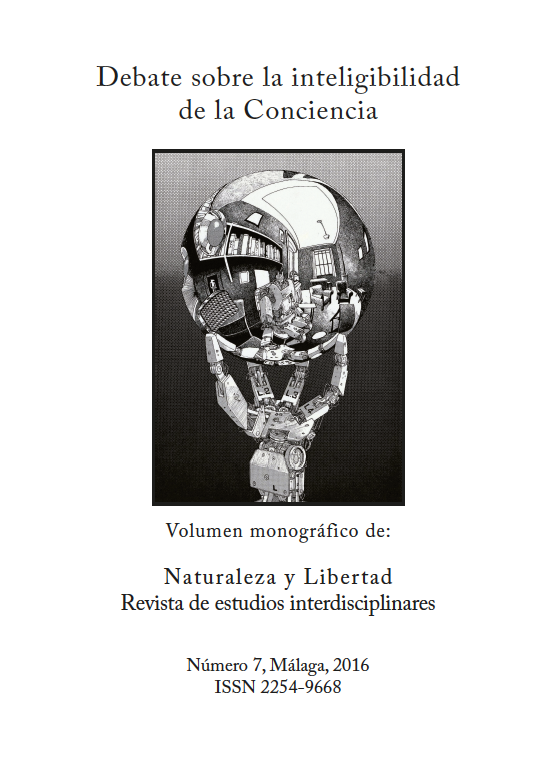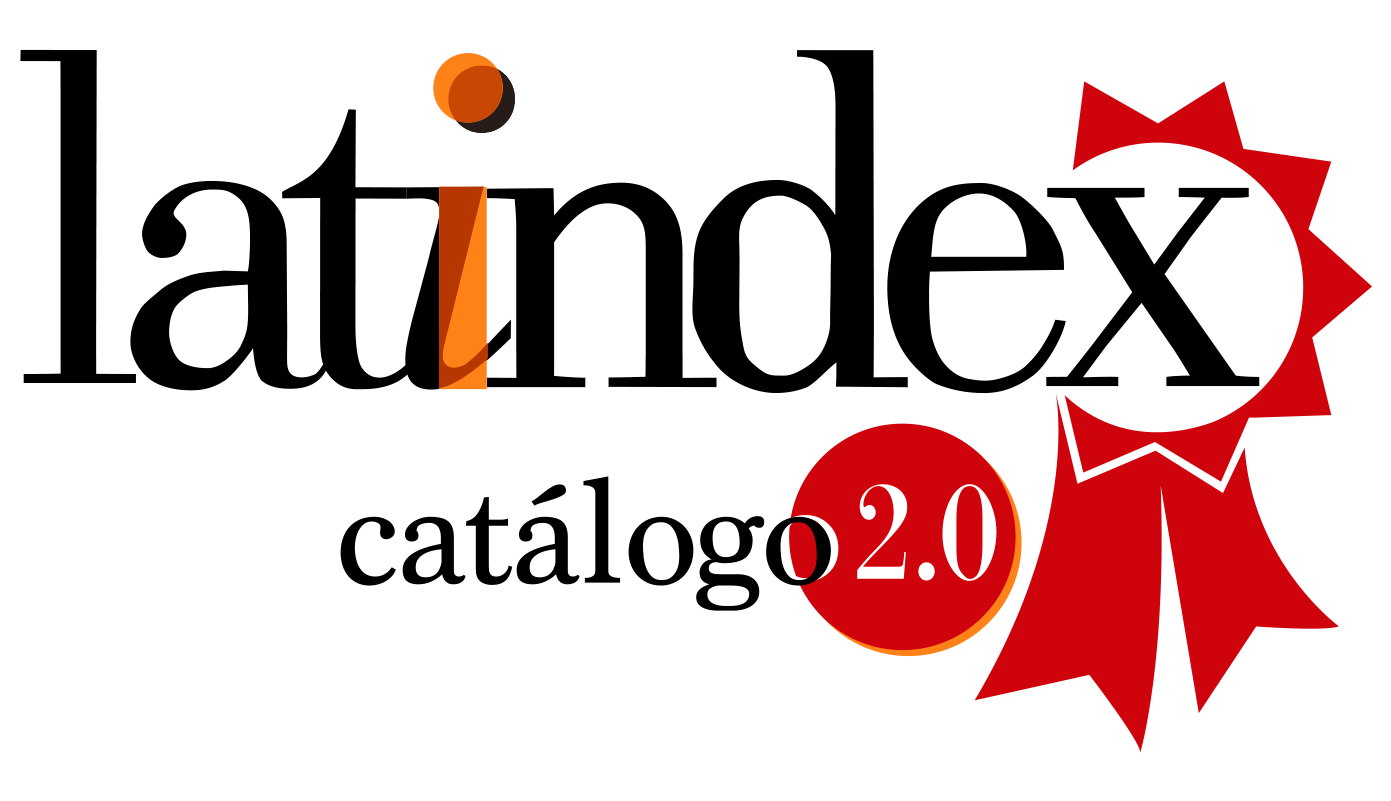Hacia un modelo integral de la conciencia humana
DOI:
https://doi.org/10.24310/NATyLIB.2016.v0i7.6333Keywords:
conciencia, modelo, paisaje epigenético, persona, causalidad simultánea, teleología, vida individualAbstract
Uno de los grandes retos que tienen los científicos es comprender la estructura y el funcionamiento de la conciencia humana. En este campo la conciencia emerge y se identifica con el cerebro. Este modelo no es falso pero es incompleto. Para perfeccionarlo se toma como punto de partida el modelo del paisaje epigenético propuesto por el biólogo C. H. Waddington. Se recupera la causalidad simultánea, tanto mutua como instantánea. Se recupera también el carácter teleológico de la conciencia humana. La describo como un saber vital que conforma nuestras maneras de ser pensar y actuar, tanto en estado de vigilia como de sueño. La conciencia no emerge del cerebro sino de la vida integrada de la personaDownloads
Metrics
References
E. Agazzi, La ciencia y el alma de occidente, Madrid, Tecnos, 2011.
L. Alvarez Munárriz, Categorías clave de la Antropología, Sevilla, Signatura Demos, 2015.
L. Álvarez Munárriz, “Límites del modelo neurobiológico de la conciencia”, en L. Alvarez Munárriz (Edit.): El poliedro de la conciencia: cerebro, interacción y cultura. Tirant Humanidades: Valencia, (2016).
L. Álvarez Munárriz, “La compleja identidad personal”, Revista de Dialectología y Tradiciones Populares, vol. LXVI/2, 2011.
M. Allen, “Compelled by the diagram thinking through C. H. Waddington’s Epigenetic Landscape”, Contemporaneity 4/1, 2015.
A. P. Anokhin, “Genetic, brain and personality: searching for intermediate phenotypes”, en Absher, J. R. & Cloutier, J. (Eds.), Neuroimaging personality, social cognition, and character,
Amsterdam, Elsevier, 2016.
J. Arana, La Conciencia Inexplicada. Ensayo sobre los límites de la comprensión naturalista de la mente, Madrid, Biblioteca Nueva, 2015.
J. Arana, “Determinismo” En J. Arana, (Ed.), Filosofía de la naturaleza, Granada, Comares, 2016.
G. Bachelard, La dialéctica de la duración, Madrid, Villalar, 1950.
J. Baedke, y T. Schöttler, “Visual metaphors in the sciences: the case of epigenetic landscape images”, Journal for General Philosophy of Science 47/2, 2016.
J. M. Baldwin, "A New Factor in Evolution”, American Naturalist 30, 1896.
E. Bapteste y J. Dupré “Towards a processual microbial ontology”, Biology & Philosophy, 28/2, 2013.
B. Blanco et al. “Neuroepigenética, en la interfase entre genoma y cerebro”, SEBBM 183, (2015):.
E. Boyden, “How the brain is computing the mind”, Disponible www.edge.org. conversation, 2016.
O. Brabant, “More than meets the eye: toward a post-materialist model of consciousness”, Explore: The Journal of Science and Healing 12/5, 2016.
S. Caianiello, “Adaptive versus Epigenetic Landscape. A Visual Chapter in the History of Evolution and Development”, En Brauckmann, S. et al. (Eds.), Graphing Genes, Cells, and
Embryos. Max Planck Institute for the Histor y of Science, 2009.
S. Carrol, “Layers of reality”. Disponible www: Edge.org, 2015.
I. R. Cohen, “Informational landscapes in art, science, and
evolution”, Bulletin of Mathematical Biology 1, 2006.
E. D Cope, “The present problems of organic evolution”, The Monist 5/4, 1895.
D. Crews y A. C. Gore, “Transgenerational epigenetics: current controversies and debates”, en T. Tollesfsbol, (Ed.): Transgenerational epigenetics: evidence and debate, London,
Academic Press, 2014.
C. Darwin, On the origin of species by means of natural selection, or the preservation of favoured races in the struggle for life, London, John Murray, 1859.
R. Dawkins, “This is my vision of «life»”, Disponible www: Edge.org. 2015.
D. Deans y K. A. Maggert, “What do you mean, «Epigenetic»?”, Genetics 199, 2015.
D. Dennett, Consciousnes explained, New York, Allen Lane, 1991.
D. Dennett, Darwin’s dangerous idea. Evolution and the meaning of life, New York, Simon & Schuster, 1995.
D. Dennett, “The Baldwin effect: A crane, not a skyhook”. En Weber, B. & Depew, D. (Eds.), Evolution and learning. The Baldwin effect reconsidered, Cambridge, MIT Press, 2003.
D. Dennett, “Design without a designer, and the evolution of "Why?", Universitat de Girona. Càtedra Ferrater Mora de Pensament Contemporani. 2015.
D. Dennett, “Artifactual selves: a response to Lynne Rudder Baker”, Phenomenology and the Cognitive Sciences 15/1, 2016.
C. Emmeche, et al. “Levels, Emergence, and Three Versions of Downward Causation”, en: Andersen, P. B. et al. (Eds.), Downward causation. minds, bodies and matter, Århus, Aarhus University Press, 2000.
B. Falkenburg, “Cerebro y pensamiento”, en: J. Arana, (Ed.), Filosofía de la naturaleza, Granada, Comares, 2016.
G. Gottlieb, Individual development and evolution, New York, Psychology Press, 1992.
A. Hedlund-de Witt, et al. “Exploring inner and outer worlds: A quantitative study of worldviews, environmental attitudes, and sustainable lifestyles”, Journal of Environmental Psychology 37, 2014.
Th. Hinterberger, “The science of consciousness - Basics, models, and visions”, Journal of Physiology - Paris, 2016.
M-V Ho, “How development directs evolution”, en: P. C. M. Molenear, Handbook of Developmental Systems Theory and Methodology, New York, Guilford Press, 2014.
M-V Ho, “The New Genetics and Natural versus Artificial Genetic Modification”, Entropy 15,
M-V Ho, The Rainbow and the Worm: The Physics of Organisms, London, World Scientific Publishing, 1998.
P. J. Hurd, “The era of epigenetic”, Brief. Funct. Genomics 9/5-6, 2010.
Foley, R. (2016): “Mosaic evolution and the pattern of transitions in the hominin lineage”, Phil. Trans. R. Soc. B 371.
J. A. García González, “Presentación”, Contrastes 11, 2006.
S. T. Hyde, “Crystals: animal, vegetable or mineral?”, Interface Focus 5, 2015.
J. Jaeger y N. Monk, “Bioattractors: dynamical system theory and the evolution of regulary processes”, The Journal of Physiology 592/11, 2014.
D. Jou, Materia y materialismo, Barcelona, Pasado y Presente, 2015.
I. Kant, Kritik der reinen Vernunft, 1, Frankfurt am Main, Shurkamp, 1787/1956.
S. A. Kauffman y A. Gare, “Beyond Descartes and Newton: Recovering life and humanity”, Progress in Biophysics and Molecular Biology 119, 2015.
S. Kauffman, “Cosmic mind?”, Theology and Science 14/1, 2016.
M. E. Koltko-Rivera, “The psychology of worldviews”, Review of General Psychology 8/1, M. 2004.
C. Koch, “La teoría de la información integrada”, Cuadernos Mente y Cerebro 13, 2016a.
C. Koch. et al. “Neural correlates of consciousness: progress and problems”, Nature Reviews | Neuroscience 17/307, 2016b.
S. Langer, Mind: An Essay on Human Feeling, Vol. I, Baltimore, Johns Hopkins Press,
B. M. Lester et al., “Introduction to the Special Section on Epigenetics”, Child Development 87/1, 2016.
C. Lisón Tolosana, “El relativismo en argumento cultural”, Real Academia de Ciencias Morales y Políticas, 2016.
M. Lock, “Comprehending the body in the era of the epigenome”, Current Anthropology 56/2, 2015.
Ph. Low et al. “The Cambridge Declaration on Consciousness”, Francis Crick Memorial Conference on Consciousness in Human and non-Human Animals, Cambridge, University
of Cambridge, 2012.
J. Mann, “Epigenetics and memigenetics”, Cell. Mol. Life Sciences 71, 2014.
P. Marchais y A. Cardon, “Similitudes et différences des modéles constructivistes cliniques et informatiques en psychiatrie”, Annales Médico-Psychologiques 174, 2016.
M. Maruyama, “The second cyberntics: Deviation-Amplifying mutual causal process”, American Scientist 5/2 (1963).
M. Meloni,G. Testa, “Scrutinizing the epigenetics revolution”, BioSocieties 9/4 (2014).
G.W. Miller, The exposome: a primer. The environmental equivalent of the genome, Rollins School of Public Health, Emory University, 2014.
J. M. Moran, Cognitive neuroscience of self-reflection”. En Absher, J. R. & Cloutier, J. Eds.), Neuroimaging personality, social cognition, and character, Amsterdam, Elsevier, 2016.
O. Y Naumova et al. “Epigenetic patterns modulate the connection between developmental dynamics of parenting and offspring psychosocial adjustment”, Child Development,
D. Noble “Evolution beyond neo-Darwinism: a new conceptual framework”, The Journal of Experimental Biology 218, 2015a.
D. Noble, “Conrad Waddington and the origin of epigenetics”, Journal of Experimental Biology
, 2015b.
W. F. Overton, “Relational developmental Systems and developmental science”, en: P. C.
M. Molenear, P. C. M. (Eds.): Handbook of developmental systems theory and methodology, New York, Guilford Press, 2014.
S. Pinker, “Behavior = Genes + Environment”. Disponible www: Edge.org., 2014.
R. Plomin, “Why we're different”. Disponible www: Edge.org.: 2016.
K. S. Pollard, “Uniquely human”, The Scientist August, 2016.
F. Ponz y A. M- Barber, Neurofisiología, Madrid, Síntesis, 1989.
A. P. Rasnitsyn, “Epigenetic theory of evolution in short”, Invertebrate Zoology 12/1, 2015.
O. Rieppel, “Preformationist and epigenetic biases in the history of the morphological character concept”, en: G. P. Wagner (Ed.), The character concept in biology, Amsterdam, Elsevier, 2001.
M. Ridley, The evolution of everything. How new ideas emerge, New York, Harper, 2015.
G. E. Robinson, “Beyond nature and nurture”, Science 304, 2004.
M. Scheler, Der Formalismus in der Ethik und materiael Wertethik, Vol. 2, Bern, Francke Verlag, 1918/1960.
J. Searle “Theory of mind and Darwin’s legacy”, PNAS 110/2, 2013.
C. S. Sherrington, Hombre versus naturaleza, Barcelona, Tusquets, 1984.
C. S. Sherrington, Man on his nature: the Gifford lectures, Edinburgh, 1937-8, Cambridge, The University Press, 1963.
G. Tononi et al. “The neurology of consciousness: an overview”, En Laureys, S. et al. (Eds.), The neurology of consciousness. Amsterdam, Elsevier, 2016a.
G. Tononi. et al. “Integrated information theory: from consciousness to its physical substrate”, Nature Reviews | Neuroscience 17, 2016b.
E. Tronick y R. G. Hunter, “Waddington, Dynamic Systems, and Epigenetics”, Front. Behav. Neuroscience 10, 2016.
J. von Uexküll, “Die Rolle des Subjekts in der Biologie”, Die Naturwissenschaften 19, 1931.
J. von Uexküll, Theoretical Biology, New York, Harcourt, 1926.
C. H. Waddington, How animals develop, New York, Norton and Company, 1936.
C. H. Waddington, Organisers and Genes, Cambridge, Cambridge University Press, 1940.
C. H. Waddington, The strategy of the genes. A discussion of some aspects of theoretical biology, London, Allen
& Unwin, 1957.
C. H. Waddington, “Evolutionary systems - Animal and human”, Nature 183, 1959.
C. H. Waddington, “Towards a Theoretical Biology”, Nature 218, 1968
C. H. Waddington, “Does evolution dependent on random search”, en: C. H. Waddington, C. (Ed.), Towards a theoretical biology. 1. Prolegomena: an IUBS symposium, London, Aldine Publishing
Company, 1968.
C. H. Waddington, “Determinism and life”, en : A. Kenny (Edit.), The Nature of Mind: The Gifford Lectures 1971/2, Edinburgh, Edinburgh University Press, 1972.
C. H. Waddington, The ethical animal, London, G. Allen & Unwin, 1960.
C. H. Waddington, Behind appearance: A study of the relations between painting and the natural sciences in this
century, Cambridge, MIT Press, 1970.
C. H. Waddington, The Evolution of an Evolutionist, Edinburgh, Edinburgh University Press, 1975.
A. R. Wallace, Natural selection and tropical nature: Essays on descriptive and theoretical biology, London: Macmillan, 1895.
S. Wright, “The roles of mutation, inbreeding, crossbreeding and selection in evolution”, Proceeding Sixth. Int. Cong. Genetic 1, 1932.
W. E. Zame y S. M. Scheiner, “A conceptual framework for organismal biology: linking theories, models, and data”, Integrative and Comparative Biology 54/5, 2014.
Downloads
Published
How to Cite
Issue
Section
License
Those authors who have publications with this journal, accept the following terms:
1. Copyright and licensing information are clearly described on the journal’s web site: all content published in Naturaleza y Libertad is open acces without limit, and are subject to the Attribution-NonCommercial-ShareAlike 4.0 International (CC BY-NC-SA 4.0) license. The full text of which can be consulted at https://creativecommons.org/licenses/by-nc-sa/4.0/
2. It is the responsibility of the authors to obtain the necessary permissions for the images that are subject to copyright. The authors whose contributions are accepted for publication in this journal will retain the non-exclusive right to use their contributions for academic, research and educational purposes, including self-archiving or deposit in open access repositories of any kind. The electronic edition of this magazine is edited by the Editorial de la University of Malaga (UmaEditorial), being necessary to cite the origin in any partial or total reproduction.
3. This journal allows and encourages authors to publish papers on their personal websites or in institutional repositories, both before and after their publication in this journal, as long as they provide bibliographic information that accredits, if applicable, your posting on it.
4. In no case will anonymous papers be published.





18.png)













